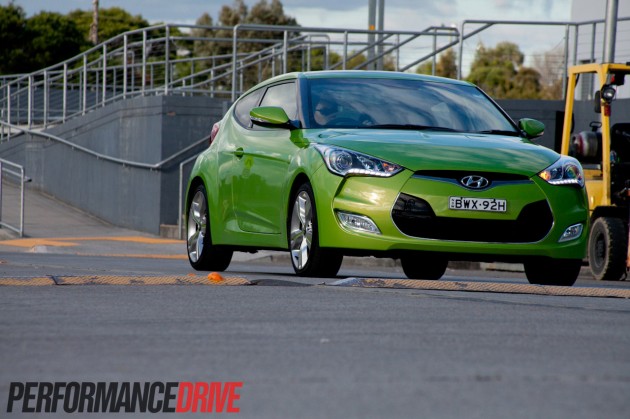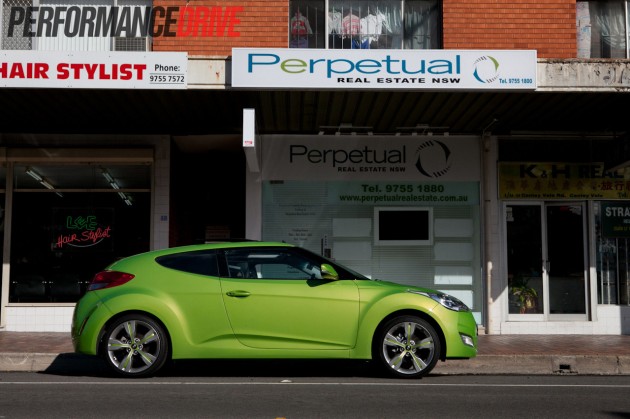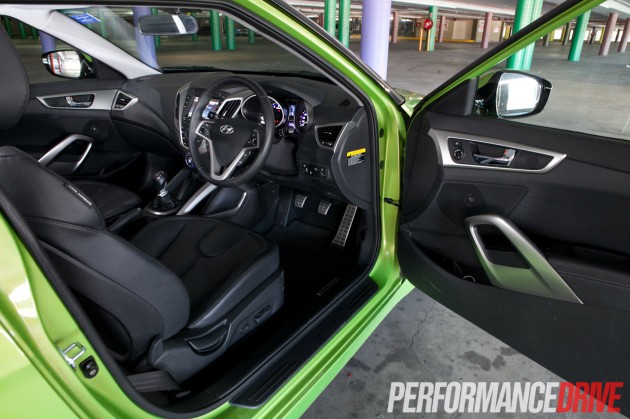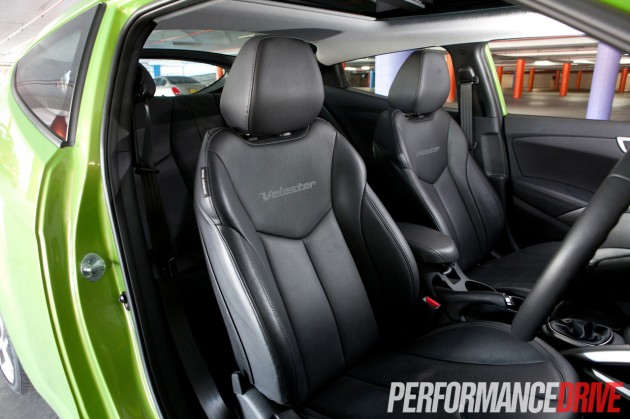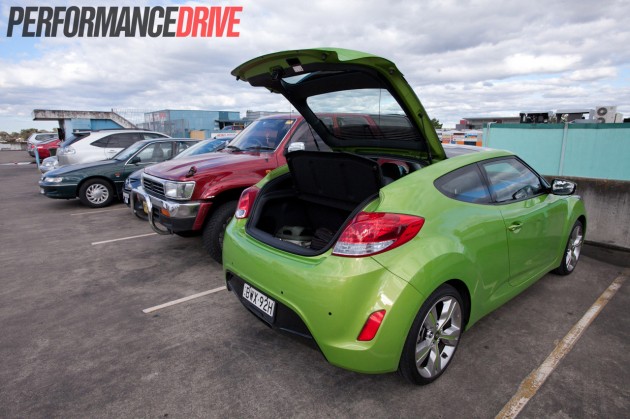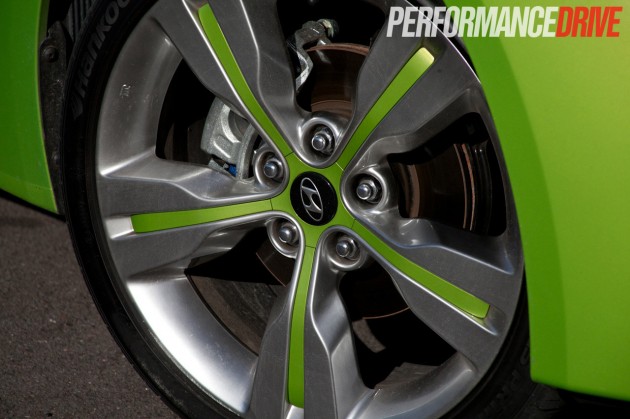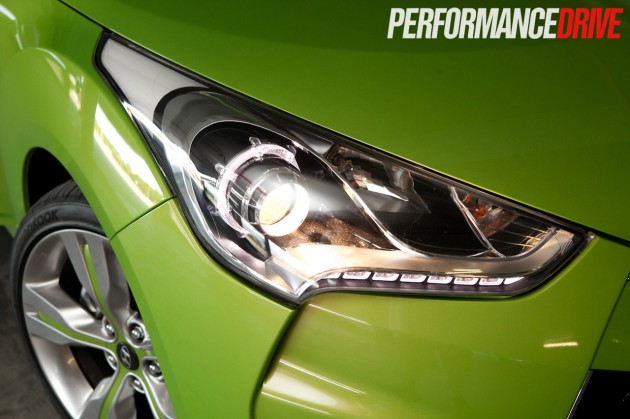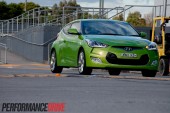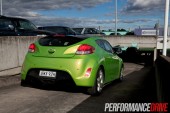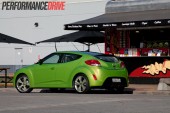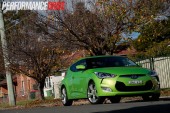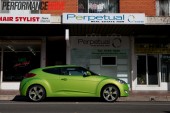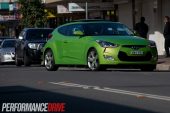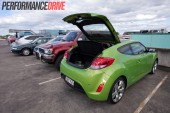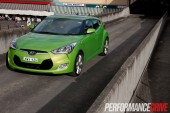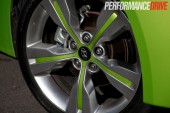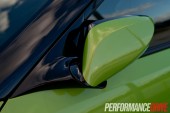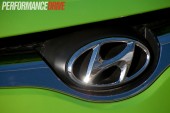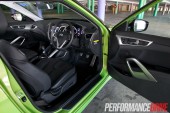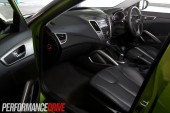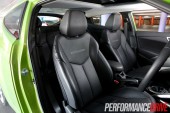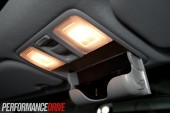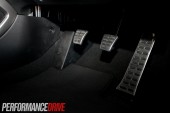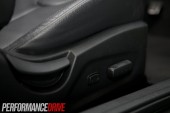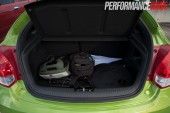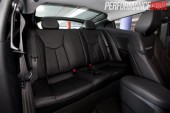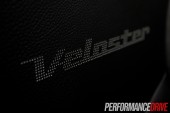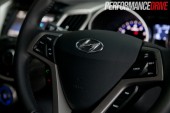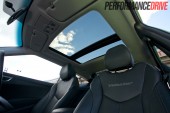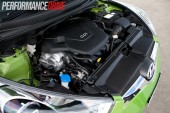Although the 2012 Hyundai Veloster Plus does come with plenty of kit, is it worth the extra $4000 over the $23,990 entry-level Veloster? Let’s find out.
2012 HYUNDAI VELOSTER PLUS – PROS AND CONS
PROS:
- Supermodel looks
- Comfortable and airy interior
- Very good entertainment system
- Innovative third door for rear passengers
- Direct and lively steering
- Five-year, unlimited kilometre warranty
CONS:
- Wheels with colour coded spokes look tacky
- Interior trim quality and choice questionable
- Vague gear shift feel
- Inconveniently placed reverse button
2012 HYUNDAI VELOSTER PLUS – OVERVIEW
The Hyundai Veloster is undeniably a hit, consistently leading sales in the Sports Car under $60,000 category every month. The range topping Veloster Plus is armed to the teeth and aims squarely at the lavishly equipped hatchback/coupe segment, but will it gun down any targets?
We loved the base model, and with so much more goodies thrown in, how can we not say the same about the Veloster Plus? The manual option is for those who unquestionably want a more involving drive, and starting at $27,990, it looks pretty good value too. The excellent dual-clutch transmission auto developed by Hyundai is a $2000 option.
2012 HYUNDAI VELOSTER PLUS – ACCOMMODATION AND EQUIPMENT
A familiar trend with South Korean cars is to load them with as many gizmos as possible, then price them around 20 per cent cheaper than the rivals.
The 2012 Hyundai Veloster Plus is no exception, adding a panoramic sunroof, heated and foldable side mirrors, auto climate control, leather seats, a sunglasses compartment, and push-button start with a proximity smart key. Projector headlamps are also added to the long, long list of standard equipment.
The large seven-inch LCD touch-screen interface dominating the centre console combines your usual radio/CD player audio with iPod connectivity, Bluetooth handsfree, a rear-view camera, and Divx movie playback capability.
The multimedia screen is not just for show either, it pounds tunes through a premium set of speakers, with two tweeters and a sub-woofer, of which is powered by an external amplifier. We found that it sounds the best when set to ‘Concert’ mode. With the car squarely aimed at young, tech savvy fashionistas, the Veloster Plus is off to a great start.
The auto climate control also uses the screen to tell you how cool/warm you are setting the cabin’s temperature.
With the panoramic sunroof you’ll never drive with the roof blind closed, as it’s tinted heavily enough to let in some rays without burning your scalp off. The cabin feels light and airy, and we also found that it adds an additional inch of headroom compared to the base Veloster without the sunroof.
The centre console design takes inspiration from a motorcycle, and the upright air vents are a brilliant touch. The sportily designed instrument binnacle is more Kawasaki than Korean hatch, jutting out and demanding your attention.
The steering wheel is leather wrapped and has all the buttons for radio, cruise control and Bluetooth call answer/cancel. However, you’ll have to mess around with the LCD interface to call someone, and it doesn’t scan through your phonebook automatically like most other systems do. This could cause problems while driving. Luckily, Hyundai has made it so you can’t use the touch-screen to call anyone while the car is above walking speed.
While the cabin is airy and expansive, the multitude of plastics used can be overwhelming. It looks like the designers couldn’t make up their minds about the materials and decided to put them all in, right after their budget got downsized. The worst offenders are the door handles, which are made from chromed plastic. These seem quite flimsy and fragile.
At night, the cabin becomes something entirely different. The darkness covers the bad bits, and the entire interior gets bathed in baby blue back lighting from the console. The instrument cluster looks especially superb. It fades in and out when you turn on or turn off the car, putting on a show for the driver.
The leather seats look pretty cool, but for such a low slung car you sit pretty high up, and it gives a commanding view over the dashboard and bonnet.
Start the car up, step on the light clutch, and this is where the ergonomics go a bit awry. Our test car is a manual, and its gear lever is massive and chunky. Being a six-speed gearbox, it has a dinky little lever where your index finger would normally go for selecting the reverse gear. While it feels intuitive when you want to reverse your car, in normal driving the overly large gear knob and the lever placement combines to feel extremely unwieldy and fidgety.
Those in the back won’t have to worry about this issue though, and they’ll happily get in the rear thanks to the third passenger side rear door. It’s extremely practical and every rear passenger we had would attest how much easier it is getting in and out compared to a coupe or a two-door hatchback. While headroom is at a premium due to the sloping roof, there is actually useable knee space for the average-size person.
The driver’s seat can lean forward in case of emergency exits, but with the rear door so handy, no one will yell shotgun anymore.
The sexy tailgate and sloping rear glass conceals a huge 440-litre boot, on par with cars like the Honda Civic, Toyota Corolla, and the Mazda3. With the option to fold the rear seats down for some serious storage space, the Veloster Plus is looking mighty useful as a daily driver.
2012 HYUNDAI VELOSTER PLUS – DESIGN AND SAFETY
Simply put, the Veloster is a visual blow to the sternum. It stops motorists and pedestrians alike; it will part traffic like a supercar. The windscreen, A- and B-pillars wrap seamlessly around the car like a helmet visor. The buff front end has the appropriate amount of aggression, and although the bonnet vents are purely show, it lends a sporty impression to the Veloster as you peer out the windscreen onto the road.
We love how low it looks, hunching square over its 18-inch colour-coded rims… which we think are a little tacky. We reckon the standard model’s rims look much classier, and considering they are the same size, it doesn’t affect performance at all.
Hyundai has spent a lot of time on the details. You’ll notice the daytime running lights underscore the halogen headlamps menacingly, while the rear lights use long strands of LEDs to light up. The little swoops and curves in its masculine side profile add to the visual delight of the exterior. The tinted sunroof adds a certain glossy sleekness to the Veloster Plus that’s missing from its standard sibling, which is already very handsome in its own right.
With such irresistible looks, it’s small wonder that nearly every Veloster we see on the road is the premium one.
There are some quality problems though. We discovered moisture inside the headlights on our test car, which had only done slightly under 10,000kms. With Hyundai’s extraordinary five-year warranty though, it shouldn’t be more than a slight annoyance to get it fixed.
Hyundai has spared no expense in terms of safety, equipping the Veloster with front, side and curtain airbags, as well as electronic safety programs like the electronic brakeforce distribution, brake assist, and anti-lock brakes. Wheel spin or loss of traction is quelled by traction and stability control.
The stiff chassis and side intrusion beams in all of its doors helped the Veloster score 35.47 points out of 37 from ANCAP, granting it the coveted five star rating.
The Veloster also comes with Hyundai’s Active Locking Operation (HALO), which automatically locks doors when going above a certain speed. It handily unlocks automatically when you’ve stopped and pull open the door handle.
2012 HYUNDAI VELOSTER PLUS – ON THE ROAD
The new Veloster features Hyundai’s latest powerplant, the all-aluminium, double overhead cam 1.6-litre Gasoline Direct injection (GDi) four cylinder. It features variable valve timing and pumps out 103kW and 166Nm, while returning a combined fuel economy rating of 6.4L/100km.
We mainly drove the car in urban areas, and it averaged 8.9L/100km, or slightly above the official government urban rating of 8.4. While there are no official figures for its 0-100km/h time, we managed to do the century dash in 8.6 seconds.
This may seem pretty quick for what looks like an all-show-and-no-go car, but you will be surprised. With the six-speed manual gearbox, Hyundai has stacked the gears close for zippier acceleration. 100km/h comes up right at the end of second gear. As a result the GDi engine feels peppy, and even seems to get a second wind at about 4500rpm. While the gearshift feels vague, the throw is sporty and short, and combined with willing engine the Veloster Plus always seems to enjoy having a go.
What is surprising is the Veloster’s steering. It loves getting twirled. It feels light, as expected of an electric powered steering setup, but it is also precise and direct. The front wheels react instantly to your input. The nose is willing to change direction quickly too, and that hunkered down stance isn’t just for looks; it corners with impressively little body roll.
The Veloster Plus rides over bumps with much aplomb despite the low profile tyres. All this is due to Hyundai Australia’s finessing of the suspension settings, and tuning it to local roads. As a result the Veloster clings gamely onto the tarmac and the ride only gets iffy when the rear end has to deal with rough, undulating surfaces.
2012 HYUNDAI VELOSTER PLUS – VERDICT
While the interior plastics and coloured spokes are tacky, there is no denying the Veloster Plus has great looks, and our manual test car has the verve to tackle corners as well. The addition of the third door is a brilliant idea, adding genuine ease of usage while maintaining its svelte shape. Word of caution though, you will catch yourself looking at the car’s reflections in mirrors and windows as you drive along. It is just that attention grabbing.
Should you desire more performance, the turbocharged, 150kW Veloster SR Turbo is available from $31,990. With an average of 400 Velosters flying off the showroom floor each month, there is no denying the Hyundai Veloster is an exceptional package. And to answer the original question, yes, the extra kit on the Plus is worth it.
2012 HYUNDAI VELOSTER PLUS – THE COMPETITORS
Citroen DS3 DSport – 1.6-litre turbo four-cylinder, 115kW/240Nm – 1075kg – $27,990
The style king of hatchbacks before the Veloster was launched, the DS3 is available in two trims; the entry DStyle and the turbo DSport. Both only available in two-door guise.
Honda CR-Z – 1.5-litre four-cylinder with Honda IMA hybrid electric, 91kW/167Nm – 1190kg (CVT) – $34,990
The CR-Z is unbelievably fun to drive, but as a practical everyday car it’s not as good as the Veloster.
Toyota 86 – 2.0-litre boxer four-cylinder, 147kW/205Nm – 1250kg (Manual) – $29,990
Toyota’s rear wheel drive coupe promises to deliver no-frills drivers’ thrills at Korean bargain prices, and it looks set to be a winner. Caution, the rear seats are not genuinely useable.
Audi A1 Sportback – 1.2-litre turbocharged four-cylinder, 63kW/160Nm – 1040kg (Manual) – $26,500
It’s got four rings on its nose, and for many that’s all that matters. It’s no match in terms of space, but it has Audi’s fantastic build quality, design and badge snobbery.
2012 HYUNDAI VELOSTER PLUS – SPECIFICATIONS
MODEL
2012 Hyundai Veloster Plus
ENGINE
1.6-litre GDi four-cylinder
ENGINE SIZE (cc) / COMPRESSION RATIO
1591/11.0:1
BORE X STROKE (mm)
77mm X 85.4mm
POWER
103kW@6500rpm, 166Nm@4300rpm
POWER TO WEIGHT RATIO
11.82 : 1 (kg:kW)
KERB WEIGHT
1215kg
HEIGHT / WIDTH / LENGTH
1399mm / 1790mm / 4220mm
DRIVETRAIN
Six-speed manual, front-wheel drive
BRAKES
F: Ventilated discs
R: Solid discs
WHEELS / TYRES
F and R: 18in, 215/40 R18
FUEL TANK CAPACITY
50 litres
FUEL TYPE
91 RON
FUEL CONSUMPTION
Tested average: 8.9L/km
Official average: 8.4L/km
PERFORMANCE
0-100km/h: 8.6 seconds
PRICED FROM
$27,990 (manual), $29,990 (dual-clutch auto)
WARRANTY
Five-year/Unlimited kilometre
